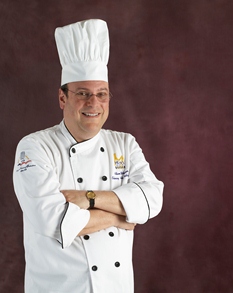50-Minute Classroom: Motivation
01 October 2011
 Educators attending the 2011 CAFÉ Leadership Conference shared scintillating tips that successfully motivate students. Among the biggest? Remember why you started cooking, and why you started teaching.
Educators attending the 2011 CAFÉ Leadership Conference shared scintillating tips that successfully motivate students. Among the biggest? Remember why you started cooking, and why you started teaching.
By Adam Weiner, CFSE
At the June 2011 CAFÉ Leadership Conference in Providence, one of the hot topics was how to keep students motivated. We had instructors from England, Canada and all parts of the United States, and this was identified as a universal problem. Interestingly enough, it was an issue for high-school, vocational, college and culinary-school instructors.
Here are some of the ideas from the 50-Minute Classroom roundtable discussion, as well as other lectures and informal discussions:
1. Get Students into the Kitchen Fast. Many instructors confessed that they bludgeon the students with food safety, kitchen safety, demonstrations, etc., before they get into the kitchen. One teacher told me that it was nearly two months before his students get to cook anything and that many drop in the first two weeks. Now, I am a stronger believer in food and kitchen safety, but strive to get your students into the kitchen as fast as possible. Making grilled cheese, scones (see “50-Minute Classroom” from July/August 2011), chocolate-chip cookies or braised endive can be done with minimum safety instructions.
2. Get on the Kitchen Floor. This one hit me like a sauté pan to the face. We as instructors are so overloaded with attendance forms, grades, lesson plans, reports, ordering, etc., that we often use the time that the students are in the kitchen to catch up on paperwork. Although the paperwork might be important to us and to the administration, the students see it from the standpoint that what they are doing is so apparently insignificant that we teachers don’t even bother to watch. Stay on the floor while your students are cooking, and look for teachable moments.
3. Throw Candy. It is an old standby, but throwing a piece of candy to a student who participates in lectures with a good question or the right answer gets people’s attention.
4. Remember Why You Are Teaching. Frequently with the day-to-day grind of teaching we forget why we started teaching and why we started cooking. Both of the keynote speakers at the Leadership Conference focused on this.
Chef John Folse stated this a number of times, saying things like:
- “The mission of teachers is to inspire. The obligation to inspire is the gift teachers have been given.”
- “We don’t know the students’ gifts. We can just inspire them to find them for themselves.”
And Chef Steve Schimoler reminded us that “We always need to remember why we got into cooking, and why we got into teaching.”
5. Portfolios. Have your students, as part of their class assignments, create a portfolio. Nowadays almost every student has a cell phone with a camera, and there are free portfolio-making Web sites. Have your students start this on the first day and then they can monitor their progress. At the end of the term they can delete all but the best examples.
6. Competitions. This is guaranteed to spark your students’ interest. If you have a short class time, do a mini-competition in as short as half an hour. Chef Schimoler had potential externs make him a peanut-butter-and-jelly sandwich. Have a PB and J competition. Have a grilled-cheese competition. Have a ramen competition featuring a package of ramen and any leftovers you have in your classroom’s kitchen. Spice it up by having the winners not have to clean that day. If you have the time, do more elaborate competitions. We do them in my class every other Friday. If you want to get a bit more complex, and only have limited time per day, try a multiple-day “Chopped”-style competition. The people who have been eliminated become judges, cheerleaders, cleaners, etc.
7. Have Fun. If you aren’t having fun teaching, then almost assuredly your students are not enjoying the class. I don’t mean that you must enjoy every second, but if you are not enjoying your day or week overall, then spend some time thinking what you can do in the class to make it more fun for you. That will make the class more fun—and more educational—for everyone.
8. Explain Why. As instructors we get so hung up in explaining HOW that we often forget to explain WHY. Alton Brown’s show, “Good Eats,” became so popular because, unlike most food shows, it explained WHY. As instructors we can motivate students by not only teaching HOW, but by teaching WHY, as well. For example, “When you sauté, cut the pieces uniformly so they will all cook at the same rate,” and “You need to label everything you put in the walk-in to minimize food wastage by knowing what everything is and what is the last date to use it.” Notice how much more informative and motivational that is as opposed to: “Cut them the same size” and “label everything.”
9. The Toughest One—Give Up Control. Chefs are control freaks. Culinary instructors might even be worse. Occasionally let your students’ passion run wild. Give them a chance once in a while to create. It doesn’t have to be a free-for-all, although that can be fun for you and the students, as well. For example, in my class today we were going over cooking principles. Each team of two had to give me one serving of a dish that was braised, sautéed, baked, broiled, grilled, steamed, poached, boiled, etc. They could use anything in the kitchen. What they gave me made me cry with pride. And, while I did that, I remembered why I started teaching culinary in the first place.
Chef Adam Weiner, CFSE, teaches a 20-week Introduction to Cooking program for JobTrain on the San Francisco Peninsula.
